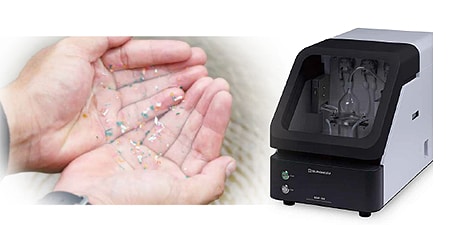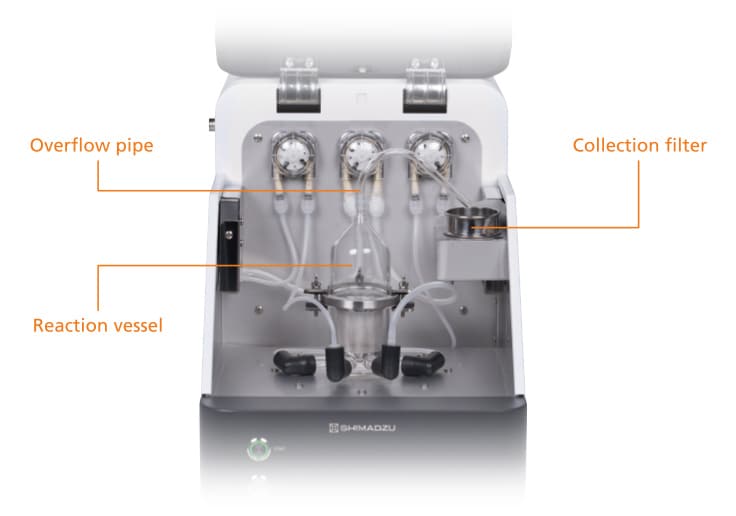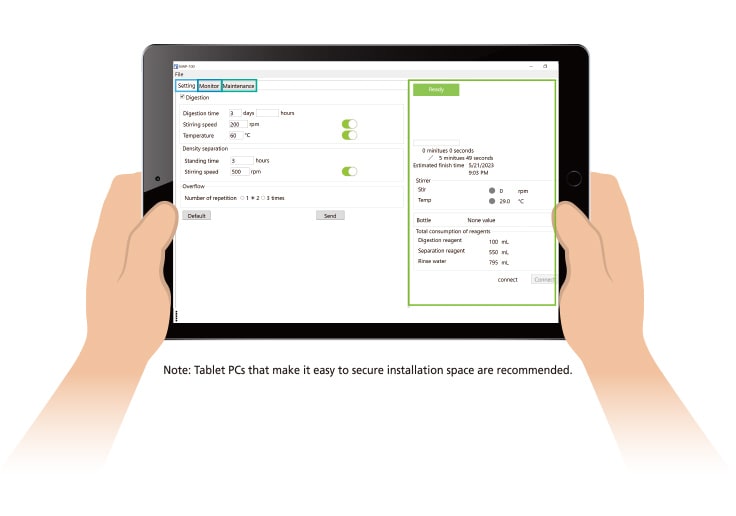MAP-100
Microplastic automatic preparation device
This automatic preparation device isolates microplastics contained in environmental surface water.

The presence of microplastics in environmental surface water such as oceans, rivers, and lakes has attracted international attention as an environmental problem, and many monitoring results have been reported.
The analysis of microplastics requires multiple steps, including sample collection, digestion and filtration, and qualitative and quantitative (size, number of particles, mass or concentration) analysis.
To accurately analyze microplastics in aqueous samples, an essential step is to isolate the particles from other components in the sample. This process normally involves digestion and separation steps.
The MAP-100 automates the typical steps needed to isolate microplastics. This improves the reproducibility of the analytical workflow, enables lab technicians to focus on other tasks, and makes handling of reagents safer.
Labor savings
Automating the complicated preparation process significantly reduces the number of man-hours required.
Reproducibility
Manual tasks by the operator are reduced, enabling highly reproducible preparation.
This improves accuracy when comparing data across analysts and laboratories.
Safety
Simplified handling of reagents by operators.
Features
-
The sample collected from the environmental surface water is placed inside the reaction vessel in the automatic preparation device. The control software is...
-
The operator configures the conditions for the automated preparation process in the simple software window. The progress during preparation is...
Videos
-
MAP-100 Microplastic Automatic Preparation Device
The narration in this video consists of a synthesized speech.
Shimadzu Corporation announced the release of the MAP-100 microplastic automatic preparation device. This product is the first in the world to automate the process of extracting and collecting microplastics in oceans, rivers, lakes, and other water in the environment. -
Automatic Preparation Device Extracts Microplastic
The MAP-100 is an automatic preparation device for extracting microplastics from environmental surface water. It automates typical preparation methods.
News / Events
-
Particle Analysis System for Microplastics has been released
This system can quickly calculate the number of particles, area, volume, mass, and individual particle qualities of microplastics based on the measurement results from an infrared microscope or an infrared Raman microscope.
-
UV-Vis Spectrophotometer UV-2600i Plus/UV-2700i Plus has been released
Accommodating a wide range of accessories, UV-2600i Plus/UV-2700i Plus excels in diverse applications, measures slight absorbance differences, and ensures robust data management and compliance.
-
UV-Vis Spectrophotometer UV-1900i Plus has been released
Experience unmatched precision and ease with UV-1900i Plus. Featuring a refined user-friendly interface, ultra high-speed scanning, and comprehensive support functions, UV-1900i Plus ensures accurate and efficient measurements for all your needs.
-
TEC MCT (Peltier Cooled MCT) Detector is now available
Equipping the AIMsight Infrared Microscope or the AIRsight Infrared/Raman Microscope with the TEC MCT (peltier cooled MCT) detector makes it possible to obtain infrared spectra without using liquid nitrogen.
-
FTIR TALK LETTER Vol. 43 has been published
The article about the Introduction to the Spectrum Advisor can be used on all Shimadzu FTIR systems controlled by LabSolutions IR. Learn the key points of infrared spectral analysis for aliphatic unsaturated hydrocarbons and aromatics.
-
Analytical Solutions for Microplastics
Shimadzu provides analytical and measuring instruments for the study of a variety of plastic materials: for R&D, characteristic evaluation of raw materials, quality control for plastic products, and deterioration analysis. With these diverse techniques, Shimadzu provides optimal solutions for microplastics research.




